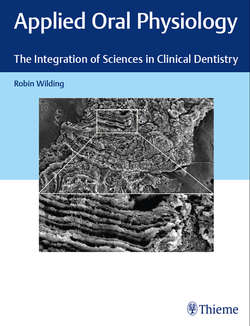Читать книгу Applied Oral Physiology - Robin Wilding - Страница 65
На сайте Литреса книга снята с продажи.
4.2.1 Salivary Pellicle
ОглавлениеSalivary pellicle is a thin layer (10 μm) of various salivary proteins which heap up on top of each other, on the surface of recently cleaned enamel, within a few hours. The smaller-molecular-weight phosphoproteins and sulpho-glycopeptides are the first to adhere to freshly cleaned enamel. Some of the phosphoproteins and calcium-binding proteins form ionic bonds with the apatite crystals of enamel. Other proteins adhere because bacteria have caused them to clump together; they are less strongly bound to the enamel surface. Most of the salivary proteins are rich in the amino acid proline and are collectively described as proline-rich proteins (PRPs). The coverage and composition of the pellicle change during its early formation. After the smaller-molecular-weight proteins, the larger glycoproteins adhere, and this stage is rapidly followed by the adhesion of the first oral organisms. Pellicle has the following influence on the oral environment:
• It protects enamel from demineralization by providing a layer of proteins, which isolates the surface from changes in the acidity of fluids surrounding the tooth.
• It influences the types of microorganisms which will adhere to the tooth surface.
• It lubricates the enamel surface and may therefore reduce the rate of tooth wear (▶ Fig. 4.4).
Given a surface onto which oral organism are able to adhere, a further defining feature of the oral environment is the fluid surrounding the pellicle and bathing all the surfaces in the oral cavity. Oral fluid is a term which best describes the mixture of substances which might be found in a sample of fluid from the mouth. It would mainly consist of saliva from the major and minor glands, each with its characteristic feature. The oral fluid would also contain gingival sulcus fluid, desquamated epithelial cells, bacteria, and some blood cells, mostly neutrophils. It is difficult to detail the exact composition of saliva as the secretions from each gland are not identical, and they all vary with the rate of secretion of saliva.
